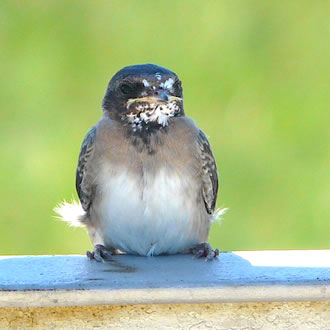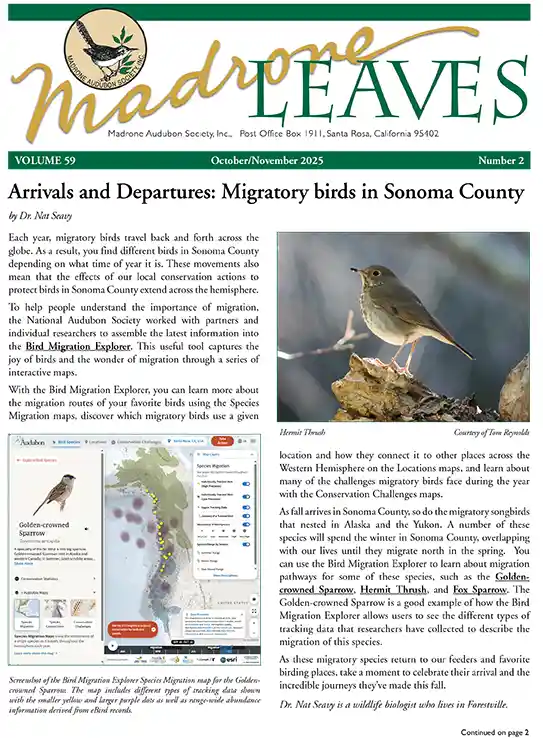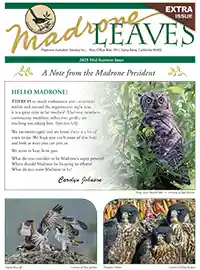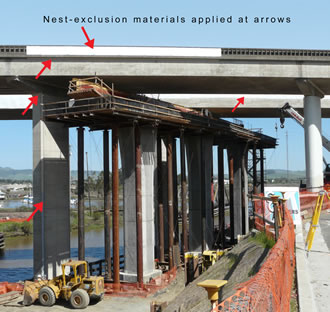Conservation News
Updates on current bird and wildlife-related issues in Sonoma County, California, and the United States.
July 14, 2020 Webinar on controversial Farallones Islands proposal
Free webinar Tuesday July 14 at 1 pm Pacific time, that will explain the threats posed by a controversial proposal by the U.S. Fish and Wildlife Service to use helicopters to disperse 1.5 tons of cereal bait laced with a powerful rodent poison, Brodifacoum, onto the Southeast Farallon Island off of San Francisco.
The problem with second-generation anticoagulant bloodthinners like Brodifacoum is that they also poison everything that eats the dying mice, or eats the bait pellets, or eats a seabird that carries the poison to mainland beaches. Because of the poison, at least a thousand Western Gulls are expected to die, according to the Fish and Wildlife Service estimates. A final decision about this scheme is likely to occur at the upcoming November 2020 virtual online meeting of the California Coastal Commission.
The California Coastal Commission will then consider whether or not the Farallones Poison Drop is consistent with California's federally-approved Coastal Plan. The Coastal Commission has a unique and decisive role to play in protecting our coastal wildlife, and Commissioners listen carefully to the public.
Contraceptive baits are now becoming available that don't spread throughout the food chain and therefore do not impact non-target wildlife. The goal of this webinar is to help bring about a less toxic and more humane solution that does not involve poisoning the entire ecosystem in the midst of our Greater Farallones National Marine Sanctuary.
This free webinar, on July 14 at 1 pm Pacific, 4 pm Eastern, will fill in the details about this controversial proposal, the pending decision, the harmless alternatives, and the precedent-setting implications for marine protected areas everywhere.
Register at www.savethefarallones.org
Note: Madrone Audubon supports the harmless alternatives to the Fish and Wildlife Service proposal discussed in the webinar.
Archive news
Cliff Swallow Litigation | Dutra Asphalt Factory Litigation | KRCB interview with Susan Kirks
Cliff Swallow Litigation
2016 Recap: Cliff Swallows in Petaluma - Third Year Settlement Comes to Close, by Susan Kirks.
As our September 2016 Leaves goes to press, the last cliff swallows are fledging at the Petaluma River Bridge. Soon, the cliff swallows will return to Argentina on an approximately 7,000 mile flight for the winter.
The end of August 2016 also marks the end of the Three Year Settlement between Plaintiffs Veronica Bowers, Native Songbird Care & Conservation, Madrone Audubon Society, Marin Audubon Society, Golden Gate Audubon Society and Center for Biological Diversity v. the Federal Highway Transportation Administration and Caltrans. We thank our members and supporters, again, for your swift response with support and donations when we reached out three years ago, beginning a litigation process because of tragic deaths of cliff swallow and other birds due to shoddily applied netting at the bridge, and now following the settlement process to conclude this year.
The construction platform spanning the west side of the bridge, about which we were concerned, a potential new large new nesting surface, was removed by Caltrans prior to arrival of the Cliff Swallows. We credit and thank Assembly member Marc Levine who hosted a press conference in March 2016 to focus attention on the cliff swallows and the bridge construction. We also credit the effective communication of our legal team from Animal Legal Defense Fund and Winston & Strawn for following through before nesting season began with our concerns. The Caltrans construction process at the bridge then completed mid Summer.
Even in this third year, where ground level construction was Caltrans' primary focus, we necessarily shared with Caltrans in June a strong concern about heavy equipment with a tall cage extension placed and operating just inches from active cliff swallow nests. Our observations via daily monitoring revealed the placement of this equipment, and its operation, obstructing the ability for adult swallows to reach the active nests, with a dangerously close placement of heavy equipment and activity so close to active nests. Caltrans was able to move forward and basically ignore our concerns because (1) the CA Department of Fish and Wildlife in 2013 amended their Lake and Streambed Agreement for a zero buffer zone (that is zero feet) between construction and active migratory bird nests, and (2) the contracted Caltrans biologist reported he did not observe any disturbance or problems with the swallows and the nests. When we queried what criteria the biologist was using for such observations, we did not receive a response, except for correspondence from Caltrans' attorney about how proud Caltrans was that no deaths or injuries had occurred to the cliff swallows in the three years of the settlement. A US Fish and Wildlife representative had related that, at a minimum, a 20 feet buffer zone is recommended between active nests and construction activity.
Caltrans has much room for improvement in processes of contractor practices and biological monitoring to ensure protection of active nests and effective exclusion of nesting. We found monitoring the construction process over these three years necessary and often observed practices or lack of practices, based on direct observation, that led to strong concerns.
Ending our settlement process in August 2016, we again thank our members for your support. We are also, again, grateful to our excellent attorneys from Animal Legal Defense Fund and Winston & Strawn. Madrone Audubon wishes to also express gratitude to our Co-Plaintiffs for standing together and standing strongly to ensure the requirements of the Migratory Bird Treaty Act are upheld. From this experience, we also received guidance from Dr. Charles Brown, national expert on cliff swallows, brought to our process by Veronica Bowers, with a new hard surface exclusion material used by Caltrans for exclusion of nesting, which we hope will continue to be used in bridge and hard surface construction projects.
Press Democrat Cliff Swallow article click here
On January 16, 2014, plaintiffs (Veronica Bowers, Native Songbird Care & Conservation, Madrone/Marin/Golden Gate Audubons, and Center for Biological Diversity) and defendant CalTrans reached a Settlement Agreement related to our litigation. The Federal Highway Transportation Administration defendant also settled with plaintiffs in March 2014. Terms of the Settlement include removal of exclusionary netting from both Petaluma bridges, use of hard surface exclusion and other safe materials for 2014 exclusionary measures, pre-nesting, during nesting and post-nesting monitoring visits, and funding for outreach to Petaluma property owners and residents who may observe nesting behavior on their structures as Cliff Swallow nesting exclusion this season from the bridges. Terms of the Settlement are enforceable through the 9th Circuit Court. We are grateful to the Animal Legal Defense Fund and Meyer Glitzenstein & Crystal legal team for negotiating these satisfactory terms of settlement. Also, Brian Gaffney, Esq., provided excellent legal support to Madrone Audubon in the early phases of the legal process.

Juvenile Cliff Swallow
On March 20, 2014, nationally renowned Cliff Swallows expert Dr. Charles Brown visited Sonoma County and joined plaintiff representatives and CalTrans personnel at the Petaluma bridges to observe the applied exclusionary materials and provide feedback. Dr. Brown also gave a fascinating talk on March 20th at the Great Blue Heron Hall, Laguna Foundation, in Santa Rosa, on his 30 years of study of Cliff Swallows.
The nonprofit coalition monitoring team assessed the exclusionary process and construction work at the Petaluma bridges during the 2014 nesting season. No bird injuries or deaths occurred as a result of the use of hard surface exclusionary material applied to the Petaluma River Bridge and Lakeville Highway Overpass. In September 2014, our coalition met with Caltrans for a post-nesting season visit to discuss the effectiveness of the new exclusion methods and the demolition and construction plans for 2014 and 2015. Check back for updates on nesting season 2015 for the Cliff Swallows.
Dutra Asphalt Factory Litigation
On February 28, 2014, the CA 1st District California Court of Appeal denied plaintiffs’ appeal (Madrone Audubon is one of multiple plaintiffs) and affirmed the Sonoma County Superior Court’s original decision in favor of the Dutra Group and Sonoma County, approving the environmental review and Dutra asphalt factory project. This decision sets in motion the Dutra Group’s ability to apply for and potentially receive permits to construct the long-opposed asphalt factory just 200 feet from Petaluma’s sensitive wetlands and tidal marsh and the nationally recognized Shollenberger Park. Such a facility would be in close proximity to Alman Marsh, Shollenberger Park and Ellis Creek.
Any birder or wildlife enthusiast who visits these areas understands the gravity of this decision. The long established and growing Petaluma Wetlands education program, voluntarily provided by Petaluma Wetlands Alliance, could be seriously and negatively impacted.
On March 25, 2014, a Petition for Rehearing filed by plaintiffs with the CA 1st District Court of Appeal, requesting a rehearing on 3 areas of the decision, was denied.
Discussions are underway about how to save the Petaluma wetland and community from construction of an asphalt plant at the approved location.
In March 2014, the Madrone Audubon Board of Directors discussed the possibility of a conservation acquisition of the Dutra property of 35+ acres, and in its place, establishing a gateway as a welcoming stopover for visitors to Sonoma County, with a low impact parking area made of permeable materials, interpretive kiosks featuring Sonoma County tourism information, a low impact trail for viewing nearby sensitive wetlands and marsh wildlife just across the river, replanting the grove of trees chopped down by CalTrans for the highway widening project interchange to facilitate tree growth for return egret nesting, and wetland restoration on the property. The California Coastal Conservancy and Sonoma Co. Agricultural Preservation and Open Space District are both invested in conservation funding in Alman Marsh and Ellis Creek. Protecting these investments, as well as protecting public health and natural resources, continue to be high priorities of consideration for us. Our Board agreed that a conservation acquisition could be the most appropriate resolution to the environmental and health concerns. The property owners would need to agree to become willing sellers for this to move toward a reality and a combination of funding sources would also be required.
For suggestions or recommendations that would be helpful for us, please contact us: susankirks@sbcglobal.net, gdbeebe@earthlink.net, dhichwa@earthlink.net.
Please check back for updates on this very concerning situation.
KRCB interview with Susan Kirks
On September 18, 2014, KRCB radio station interviewed Susan Kirks on National Audubon's recent release of climate data and it's effect on local bird species. For a link to the interview titled "Fewer birds in North Bay skies", click here [Note: Yellow-headed blackbird was intended species mentioned during interview]. For more information on Audubon's report, please go to our climate change page.
Find us on Facebook 
It's Nesting Season: trim trees in the Fall!.
Amazon Smile: donate to Madrone when you shop
Birding Quiz - test your skills.
Leaves Newsletter


Carved Bird Pins
In the 1970s, member Tom Olds hand-carved bird pins and sold them to raise money for Madrone Audubon. More
